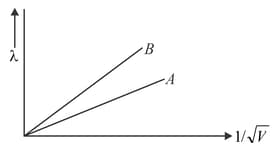Wave Nature of Matter
Wave Nature of Matter: Overview
This topic covers concepts such as Electromagnetic Wave, de-Broglie Wave and de-Broglie Wavelength.
Important Questions on Wave Nature of Matter
The energy of the electron, in the hydrogen atom, is known to be expressible in the form
sing this expression, which of the following statement is/are true?
(i) Electron in the hydrogen atom cannot have energy of .
(ii) Spacing between the lines (consecutive energy levels) within the given set of the observed hydrogen spectrum decreases as n increases.
For what kinetic energy of a proton, will the associated de Broglie wavelength be 16.5 nm?
For what kinetic energy of a neutron the associated de Broglie wavelength be ?
An particle and a proton are accelerated from rest by the same potential. The ratio of their de Broglie wavelengths would be:
An particle and a proton are accelerated from rest by the same potential. The ratio of their de Broglie wavelengths would be,
Two lines, A and B, in the plot given below show the variation of de Brogile wavelength, versus , where V is the accelerating potential difference, for two particles carrying the same charge. Which one of two represents a particle of smaller mass?

An -particle and a proton are accelerated from rest through the same potential difference V. Find the ratio of de-Broglie wavelengths associated with them.
An -particle and a proton are accelerated from rest through the same potential difference V. Find the ratio of de-Broglie wavelengths associated with them.
The wavelength of a photon is . What should be the momentum of an electron to possess the same wavelength as that of the photon?
If electron and proton are possessing same amount of kinetic energies. The de-Broglie wavelength is greater for:
The de Broglie wavelength of a wave associated with an electron is , which is accelerated through a potential difference of . Write the value of to the nearest integer.
Hydrogen atom is in its energy state. If de-Broglie wavelength of the electron is , then
An electron falls through a potential difference due to which its kinetic energy becomes times its value before the fall. The de-Broglie wavelength will be
An electron of mass when accelerated through a potential difference has de-Broglie wavelength The de-Broglie wavelength associated with a proton of mass accelerated through the same potential difference will be:-
A proton and an -particle are accelerated through a potential difference of . The ratio of the wavelength associated with the proton to that associated with an -particle is :-
Consider an wave with magnetic field The maximum value of its electric field in SI units is
De-Broglie equation is applicable to photons only.
De-Broglie wavelength is the ratio of Planck's constant and momentum of a photon.
How fast is an electron moving if it has a wavelength equal to the distance it travels in one second?
The de-Broglie wavelength associated with a ball of mass having kinetic energy is
